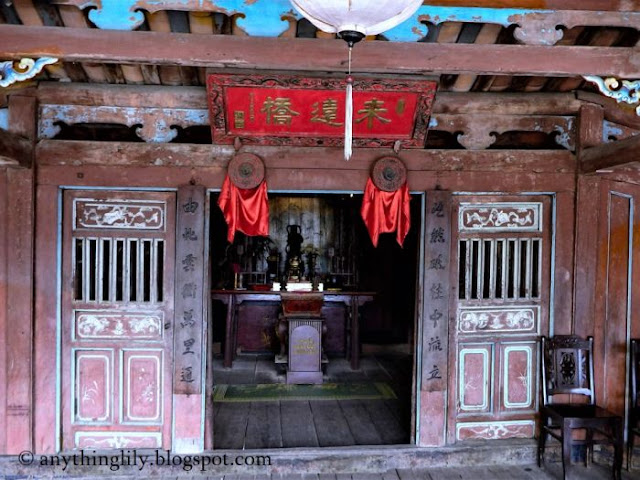Hoi An is a well preserved ancient town that has earned a spot in the list of UNESCO World Heritage Sites. Hoi An Tourism has listed 22 buildings/sites within the town that has historical significance. Visitors who want to explore these attractions are required to purchase entrance tickets which are available in a number of ticketing kiosk near the entrance of the town. Hoi An's more prominent attractions include an old Japanese bridge, communal houses, prominent old houses, art centres, museums, assembly halls of various Chinese clans, temples and pagodas. Each ticket which costs 120000 VND (approx RM22) allows a visitor to visit only 5 of the mentioned sites. To gain entry into more sites will require the purchase of more tickets but I opine it suffices to just buy one ticket and visit only the better ones.
Listed below are some of the more famous sites.
1. Japanese Covered Bridge
The Japanese Covered Bridge is a short bridge that spans a stream branching off the Thu Bon River. It was created by the early Japanese living in Hoi An to reach the Chinese Quarter across the stream. Built in 1593 and completed in 1595, this bridge is the most iconic attraction in Hoi An Ancient Town. The interior of the bridge features a small shrine.
The Japanese Covered Bridge is one of the most photographed monuments in Hoi An.
The bridge is arched and is quite short. It's architecture is rather unique.
The bridge looks more like a building than a bridge when viewed from the entrance.
One side of the bridge overlooks the stream while the other side is a room that houses a shrine.
The Shrine on the bridge.
The other external facade of the bridge is apparently not that popular among photographers.
The Japanese Covered Bridge at night
The Japanese Covered Bridge at night.
2. Phung Hung Old House
Phung Hung House is one of the largest ancient houses in Hoi An. Built in 1780, this building incorporated a fusion of Chinese, Japanese and Vietnamese architecture. Phung Hung House was a commercial shop that once traded in spices, chinaware and glassware. Today the house which operates a workshop making embroideries and also sells some of these products is a popular tourist site in Hoi An.
Phung Hung House is a two storey building.
Much of the original furniture has been retained in the house.
3. Quang Trieu (Cantonese) Assembly Hall
Built in 1885 by Chinese migrants from Guangdong, China, The Cantonese Assembly Hall served as a meeting place for the Cantonese clan who resided in Hoi An. The assembly hall features a central courtyard surrounded by buildings brightly decorated with statues and carvings. There is also a temple within the premise.Fujian (Phuc Kien) Assembly Hall was built around 1690 and functioned as an assembly place for the clan from Fujian. It was later converted into a temple dedicated to the goddess of sea who is believed to protect sailors from danger.
5. Kazik Park
This is a small memorial park built in honour of a Polish archaeologist and architect by the name of Kazimierz Kwiatkowski, aka ‘Kazik’ for his effort in restoring the ancient town, Mỹ Sơn Sanctuary and Complex of Huế Monuments. A statue of Kazak can be seen at the park. This park does not require any ticket.























2 comments :
Looking forward to visit the place one day after all this MCO done
Yes, we just have to be patient.
Post a Comment